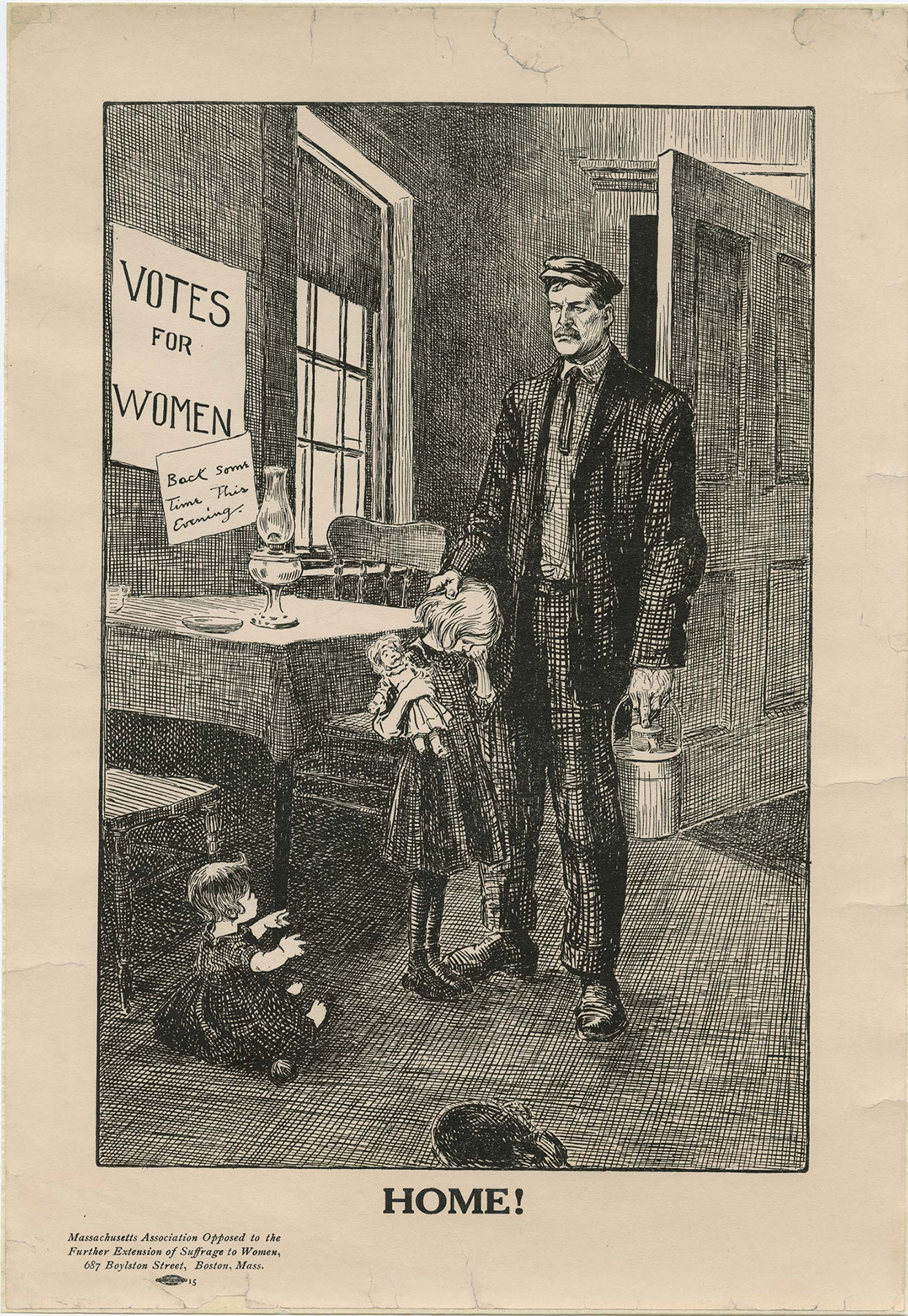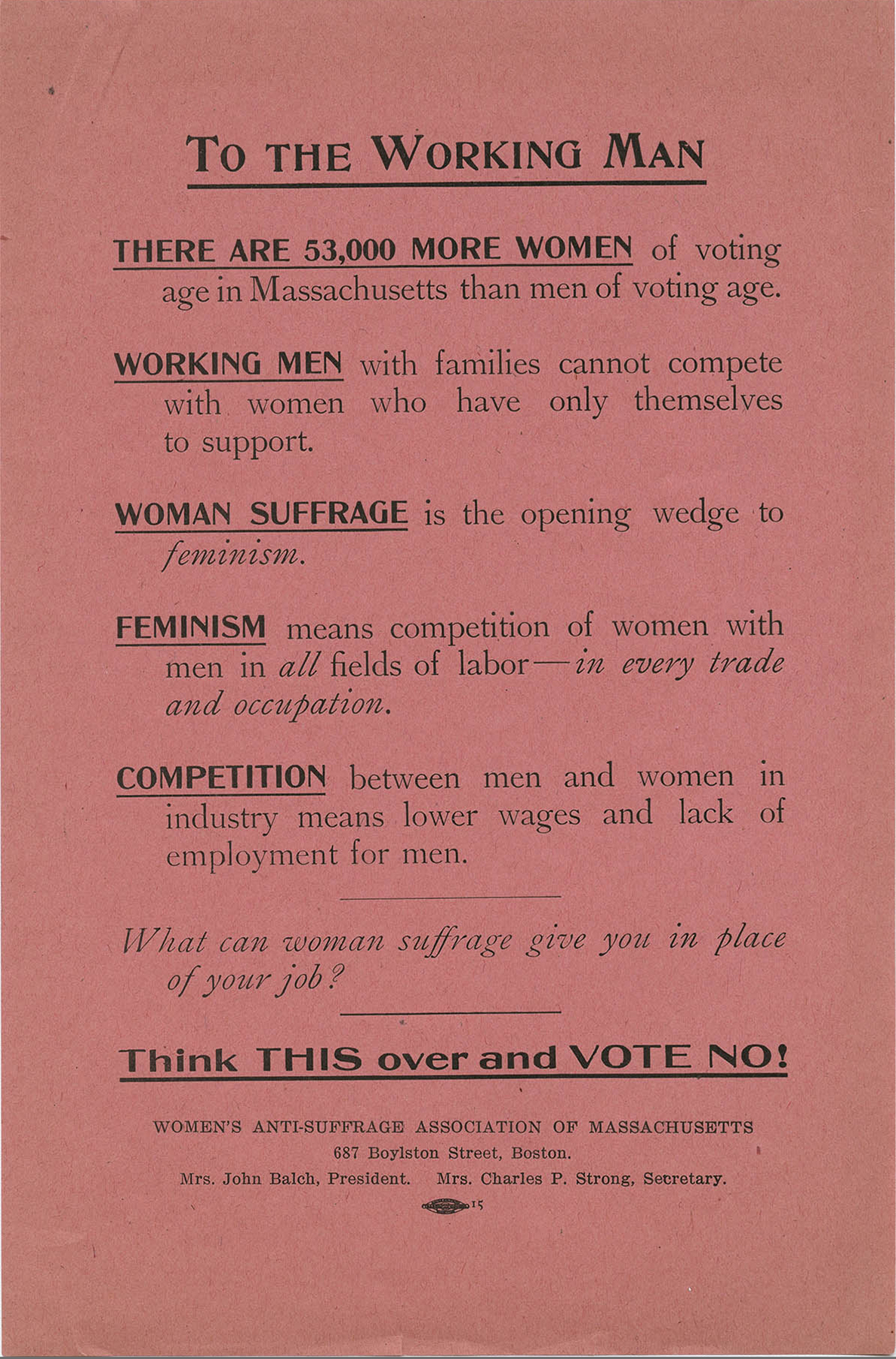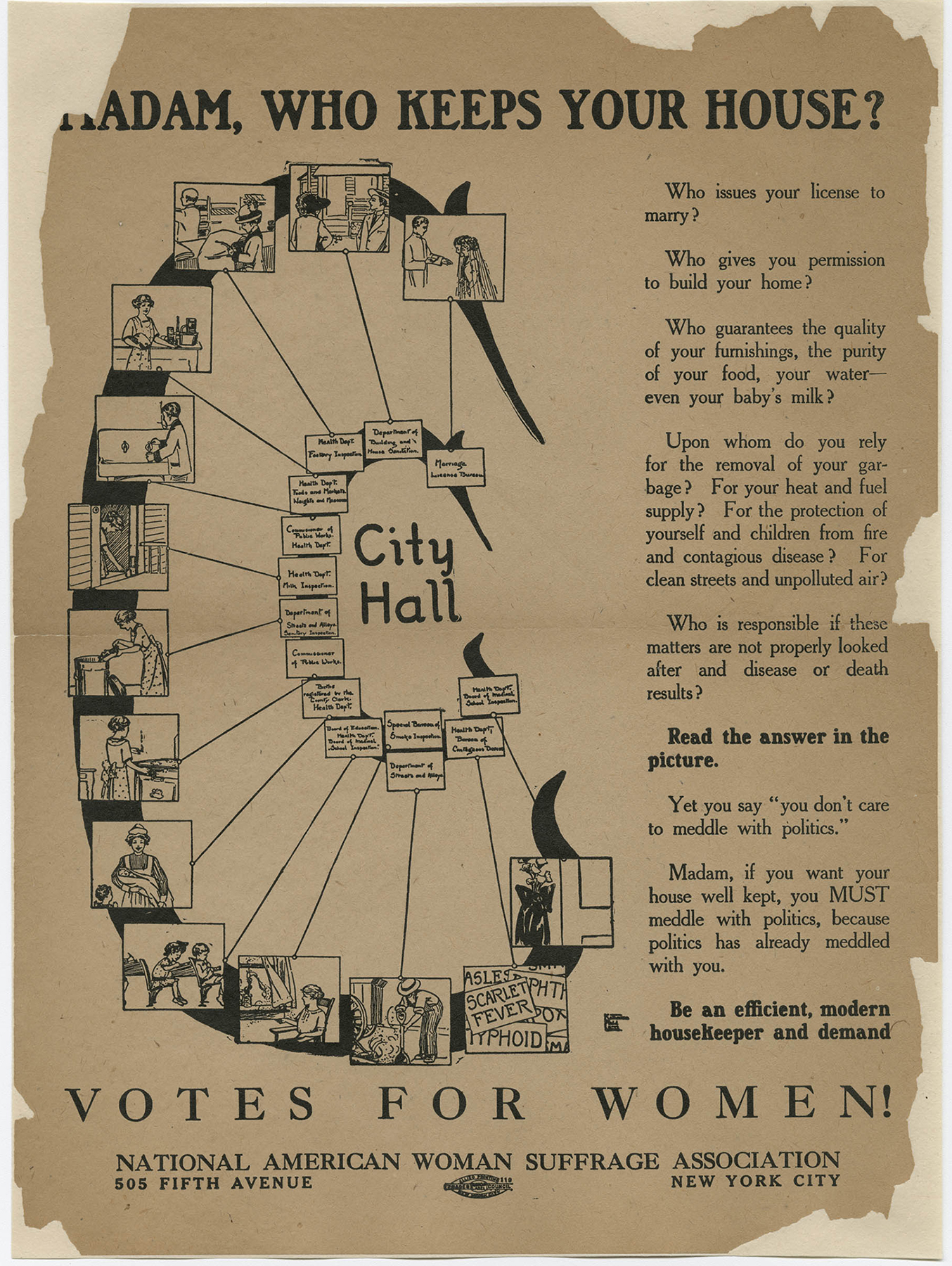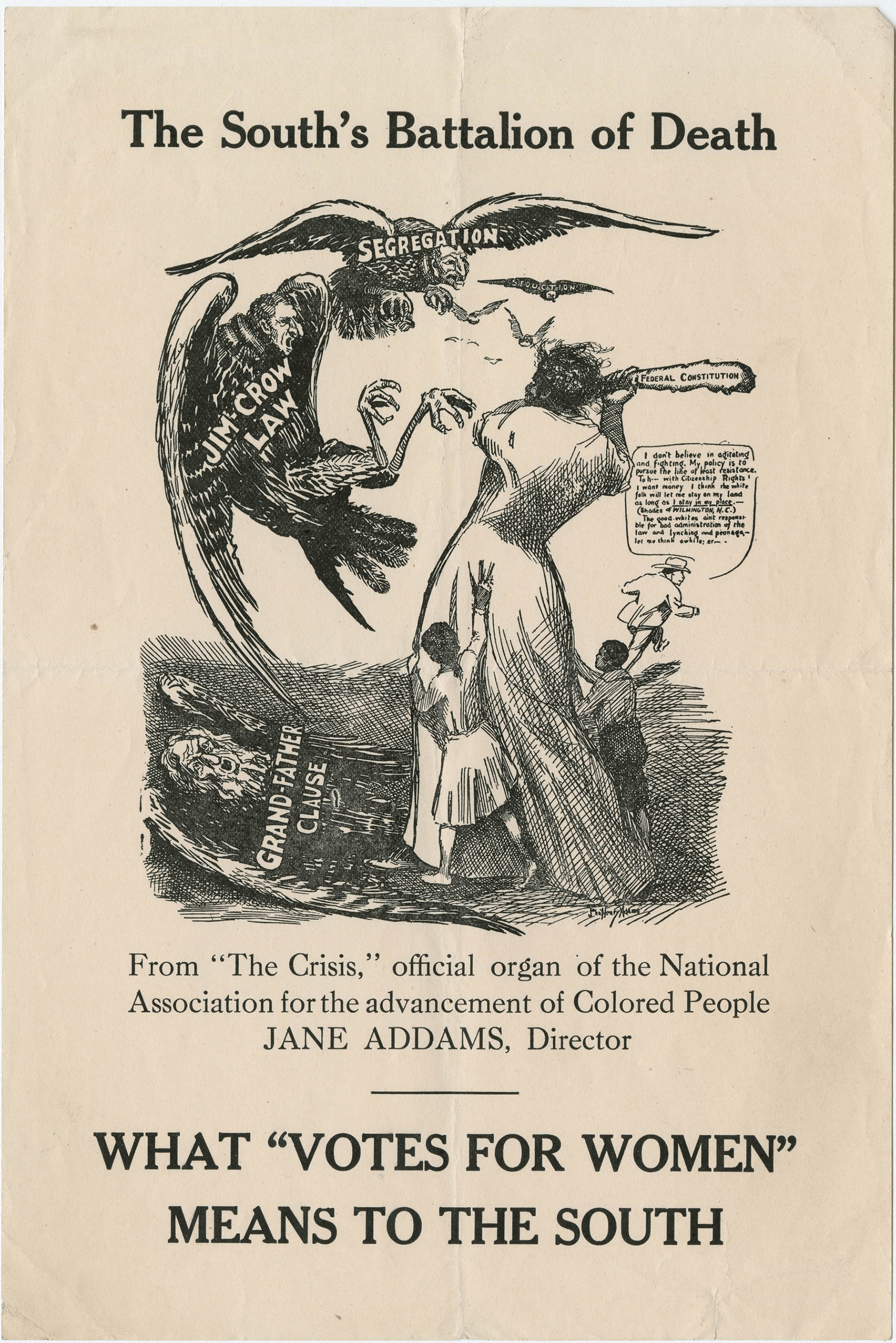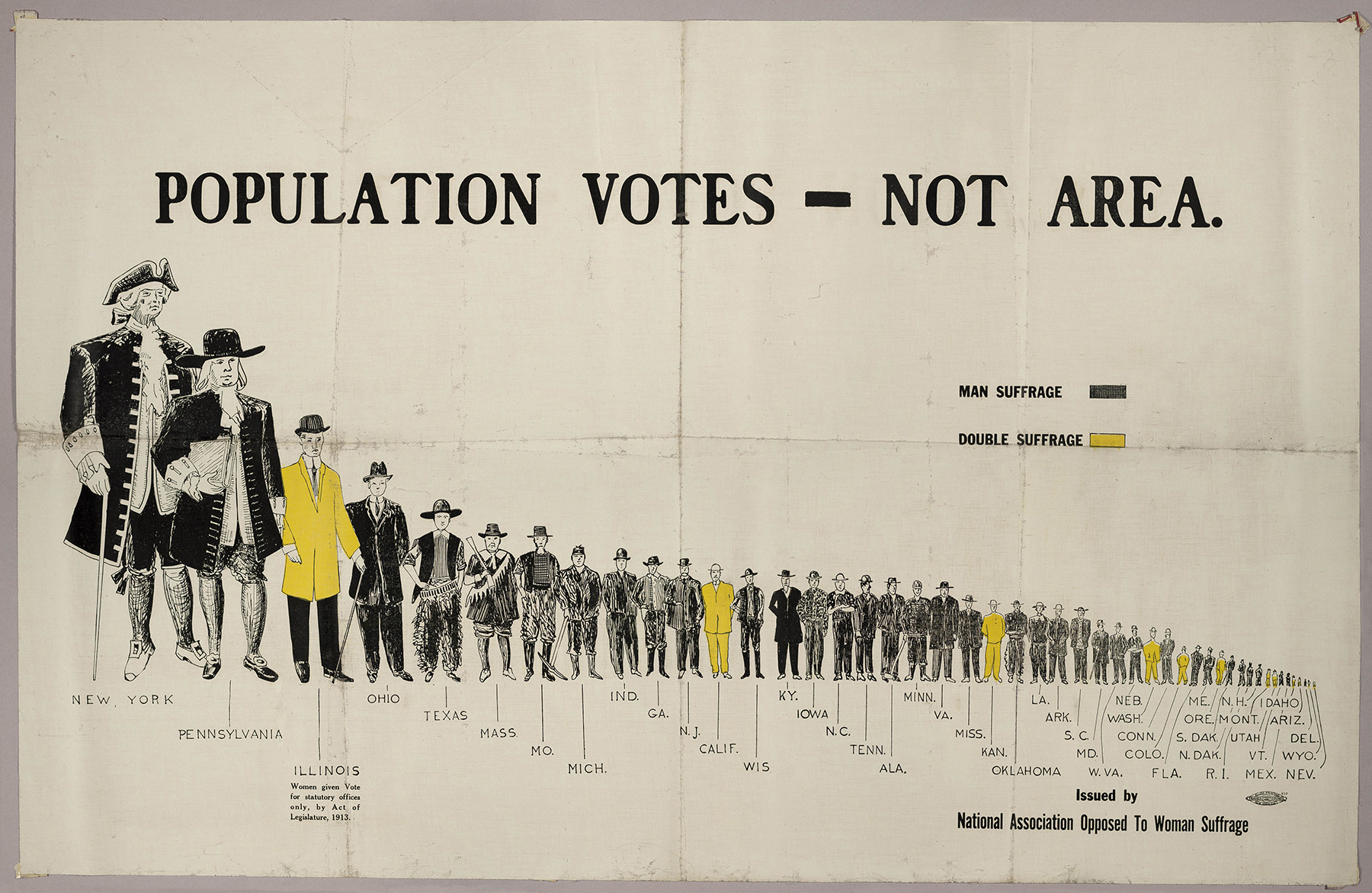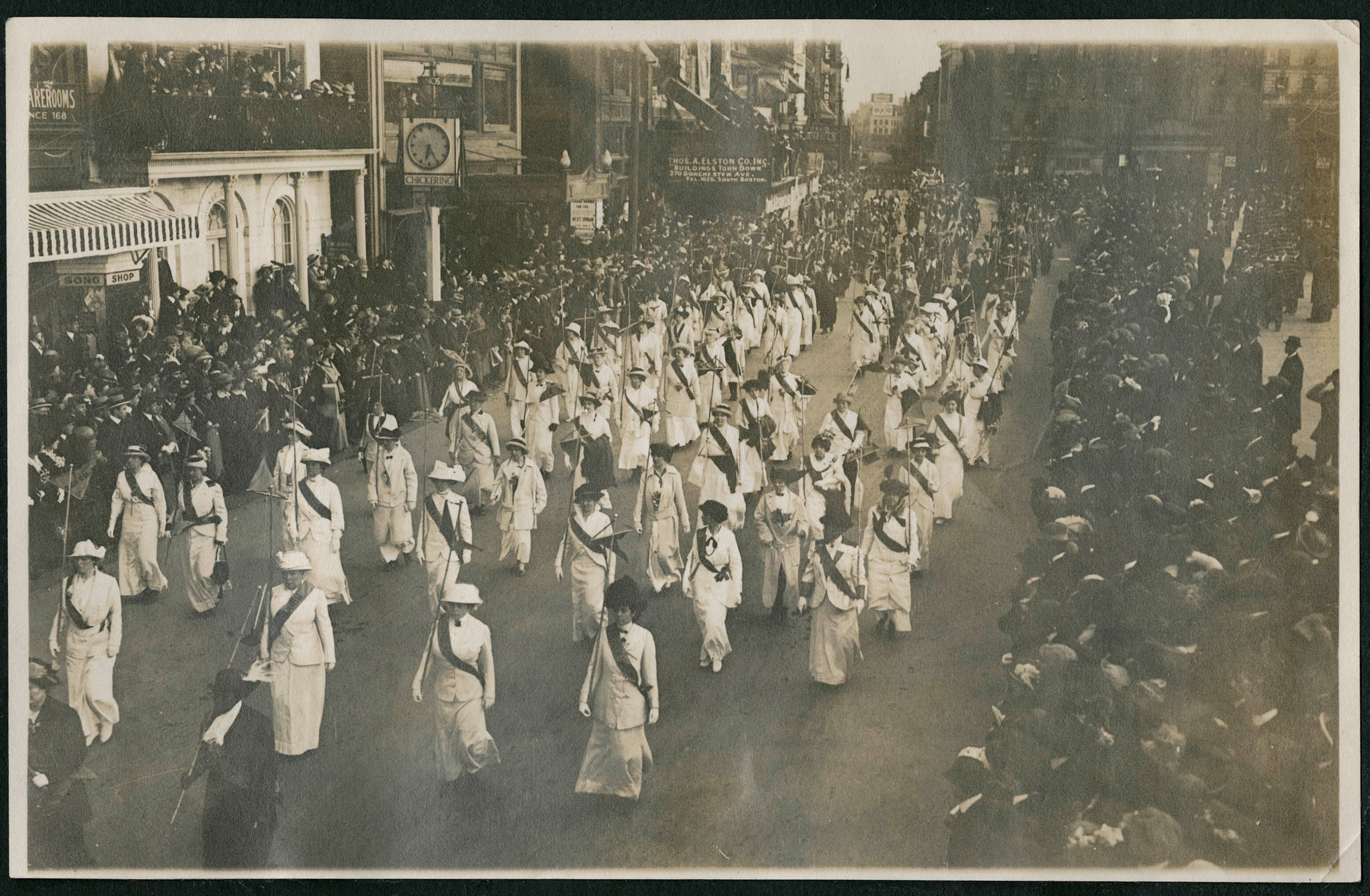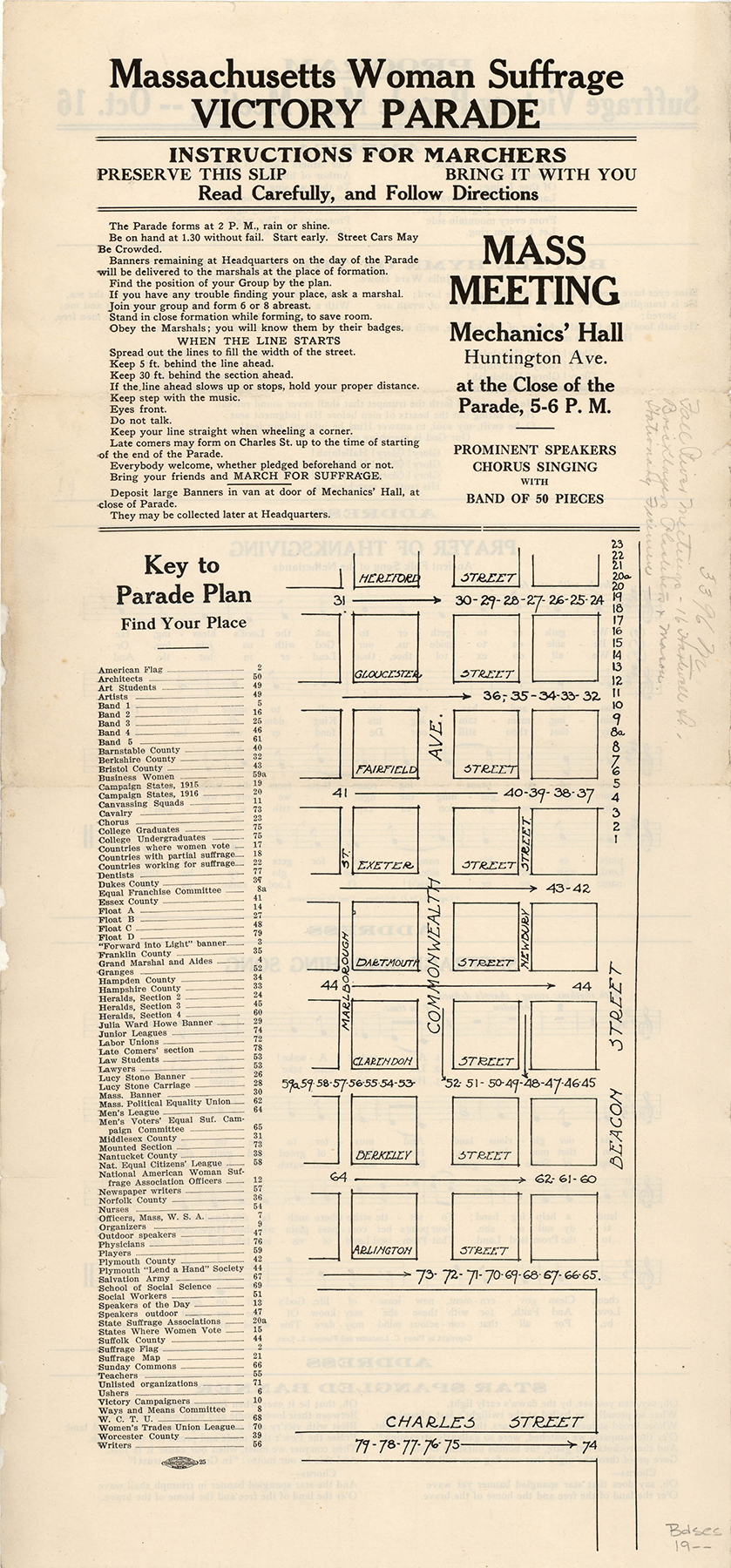Women Debate the Right to Vote
Inquiry Question 1: What claims did women make in support of and in opposition to suffrage?
Inquiry Question 2: Who were suffragists and anti-suffragists each trying to persuade?
Background Reading for Students
"Home!," Engraving, 1915
The Massachusetts Association Opposed to the Further Extension of Suffrage[the right to vote in political elections] to Women distributed this poster in support of their message that women belonged at home. In this picture, a man with his lunch pail arrives home from work. His children are upset because their mother left them alone.
On the "Votes for Women" sign the mother has left a note that she will be "back some time this evening." “Votes for Women” was the main slogan of the suffrage[the right to vote in political elections] movement.
Citation: Home! Engraving, Boston: Massachusetts Association Opposed to the Further Extension of Suffrage to Women, [1915], Massachusetts Historical Society, https://www.masshist.org/database/4156.
"What Breaks Up The Home?", Broadside, Mary Ellen Sigsbee
In this broadside[a sheet of paper with information printed on one or both sides that is meant to be shared publicly], published in New York by the National American Woman Suffrage[the right to vote in political elections] Association, suffragists[A person who supported expanded voting rights, especially to women] argue that “votes for women” will strengthen families and homes. They argued that as “homemakers,” women should be involved in the government’s policies relating to work and working conditions.
Citation: What Breaks Up the Home? Broadside by Mary Ellen Sigsbee, New York: National American Woman Suffrage Association, Massachusetts Historical Society, https://www.masshist.org/database/4177.
Glossary
Home-maker: The person (usually a woman) who is responsible for taking care of the home. This person often does not have a paid job.
"To The Working Man," Circular, MA Women's Anti-Suffrage Association
This circular[an advertisement passed out to a lot of people] is addressed to working men and claims that giving women the vote would ultimately lead to competition for jobs between men with families and, particularly, young single women.
Citation: To The Working Man, Circular by the Women's Anti-Suffrage Association of Massachusetts, From Miscellaneous collection of anti-suffrage material assembled by an officer of the Massachusetts Association Opposed to Further Extension of Suffrage to Women, 1895-1921, Massachusetts Historical Society, https://www.masshist.org/database/4208.
"Madam, Who Keeps Your House?", Broadside
This broadside[a sheet of paper with information printed on one or both sides that is meant to be shared publicly] by the National American Woman's Suffrage[the right to vote in political elections] Association argues that women need to be involved in politics (by voting) to advocate for a safe and healthy family life.
Local, state, and federal governments regulate standards for businesses, homes, food and drink, and more. During the Progressive Era, reformers worked for changes such as better working conditions in factories and stronger regulations for pasteurized milk.
Citation: Madam, Who Keeps Your House, Broadside by National American Woman Suffrage Association, New York: National American Woman Suffrage Organization, Massachusetts Historical Society, https://www.masshist.org/database/4214.
"The South's Battalion of Death," Broadside, Circa 1916
This broadside[a sheet of paper with information printed on one or both sides that is meant to be shared publicly] was published in the 1910s and shows a Black woman standing ready to use the U.S. Constitution to smash birds of prey. The birds of prey are labeled with racist laws passed by southern states following the Civil War, whose purpose was to control Black people.
This political cartoon argues that with the right to vote, Black women could help bring an end to these laws. Formed in 1909, the National Association for the Advancement of Colored People (NAACP) immediately began campaigning against segregation, Jim Crow laws[Beginning in the 1870s, cities and towns in the South–and elsewhere in the United States– passed racist ‘Jim Crow’ laws that made segregation legal. Agencies in the federal government were also segregated.], and lynching[the public killing of a person who has not received any due process or trial]. In May 1916, this political cartoon was published in The Crisis, the NAACP’s magazine, with the title: “Woman to the Rescue!”
Citation: The South's Battalion of Death, Broadside, n.d., Miscellaneous collection of anti-suffrage material assembled by an officer of the Massachusetts Association Opposed to Further Extension of Suffrage to Women, Massachusetts Historical Society, https://www.masshist.org/database/4152.
Glossary
Battalion: a large number of troops ready for battle
Jim Crow law: Beginning in the 1870s, cities and towns in the South–and elsewhere in the United States– passed racist ‘Jim Crow’ laws that made segregation legal. Agencies in the federal government were also segregated.
Grandfather clause: Following the passage of the 15th amendment, which gave Black men the right to vote, southern states passed new laws that stopped Black men from exercising that right. The ‘Grandfather clause’ was a law that only allowed men whose ancestors had voted before the Civil War to vote. Before the Civil War, Black men were not allowed to vote.
Lynching: the public killing of a person who has not received any due process or trial
"Population Votes, Not Area," Broadside, circa 1913
The National Association Opposed to Woman Suffrage[the right to vote in political elections] published this poster around 1913. Each state is represented by a man, and the states are arranged in order from highest to lowest population. The poster shows that states with high populations have (mostly) rejected giving women the vote.
The men in yellow represent states where women had the right to vote. Anti-suffrage[the right to vote in political elections] activists argued that men voted in the interests of their female family members, and so voting women would "double" the votes of their husbands and fathers.
Citation: Population Votes, Not Area, Broadside, [circa 1913] New York, N. Y. : National Association Opposed to Woman Suffrage, Massachusetts Historical Society, https://www.masshist.org/database/4143.
Suffrage Parade, Boston, MA, 1914
This black-and-white photograph was taken at a suffrage[the right to vote in political elections] parade in Boston in 1914. Crowds of onlookers watch as the women, wearing sashes, march down the street.
Citation: Suffrage parade, May 1914, From Palmer family photograph album, 1911-1917, Massachusetts Historical Society, https://www.masshist.org/database/4232.
Boston Woman Suffrage Victory Parade, 1915
On 16 October 1915, supporters of suffrage[the right to vote in political elections] in Boston staged a "Victory Parade" just weeks before a vote on an amendment that would have removed the word "male" from the articles concerning voting in the Massachusetts Constitution, thus giving women the right to vote. This broadsheet[a sheet of paper with information printed on one or both sides that is meant to be shared publicly] contains instructions for marchers participating in the parade and, on the reverse, songs to be sung during the parade and at the rally held immediately afterward.
Citation: Massachusetts Woman Suffrage Victory Parade: Instructions for Marchers, Broadsheet [Boston, 1915], Massachusetts Historical Society, https://www.masshist.org/database/1892.
Background Reading
Historical Overview: The Question of Suffrage in Massachusetts
Massachusetts Debates a Woman’s Right to Vote: Historical Overview
The Debate
To win the vote, suffragists had to convince the public to accept new gender roles for women. In the 19th century, women were expected to raise their children and manage the household, while serving as a moral compass for both their husband and children. Anti-suffragists feared that female voters would abandon their families and leave domestic chores to men. Women’s votes, they claimed, might destroy the family and, ultimately, American society.
Suffragists argued that female voters would improve American life. Like many reformers in the Progressive Era, suffragists wanted to enact governmental policy to solve social issues. They argued that women would clean up corrupt politics and support legislation that protected families. Women would still run households and care for children, and they’d also cast ballots. Boston suffragists, for example, sold cookbooks to raise money for the cause and to convince the public that women really could take care of their homes even while engaging in politics. Female voters would not only continue to care for their families; they would do it better. While the role looked different to each group, both suffragists and anti-suffragists imagined the ideal woman as being a wife and mother.
White, middle- and upper-class women led most national and local organizations—both for and against suffrage. Black women and men had a long history of supporting women’s suffrage, but white women often deliberately prevented their participation in these organizations. Black suffragists continued to fight for the vote and founded their own organizations and publications to further their goals. They viewed suffrage as one tool to fight for civil rights: securing the vote could be a means to strengthen voting protections for all Black people; bring an end to segregation; and make lynching a federal crime.
Roots of Suffrage in Antislavery Movement
The fight for women’s suffrage had its roots in abolitionism, and from the start, was interracial. In the late 1830s, women worked to advance the anti-slavery movement. In 1837, Lucretia Mott, a white woman, organized the first Anti-Slavery Convention of American Women. In 1848, Frederick Douglass, a formerly enslaved man who became an anti-slavery author and speaker, attended the women’s rights convention in Seneca Falls, New York, and supported women’s rights his entire life. Thomas Wentworth Higginson, a white Massachusetts minister and author, regularly wrote in support of women’s rights. After escaping slavery in New York, Sojourner Truth moved to Florence, Massachusetts, in 1844 and became part of a network of reformers. She traveled and spoke in support of women’s rights and against slavery.
White Women Clash over the 15th Amendment
After the Civil War, white suffragists formed two competing national organizations. The leaders of each organization, who had all been involved in the anti-slavery movement, disagreed over the 15th Amendment, which would grant Black men the right to vote. Lucy Stone and Julia Ward Howe, the American Woman Suffrage Association (AWSA) in Boston, worked to support the measure. Susan B. Anthony and Elizabeth Cady Stanton, leaders of the National Woman Suffrage Association (NWSA), opposed it. In 1890, Stone’s daughter helped unite the two groups under the National American Woman Suffrage Association (NAWSA).
Suffrage in Massachusetts?
The suffrage movement was especially strong in Massachusetts. In 1850, Worcester hosted the first national women’s rights convention. On 27 May 1866, a group of women's rights activists gathered in Boston for the organizing meeting of the American Equal Rights Association.
By 1879, Massachusetts had passed a law allowing women to vote for school committee members, a seemingly radical act in a culture where, according to suffragist Harriet Robinson, "it was thought to be a rash and dreadful act for a woman to appear at the polls, or near the ballot box, in company with the MEN." Suffrage activists—while exercising their right to this limited franchise—protested that the measure was insultingly limited and discriminated against poor women who were unable to pay the poll taxes required to cast a vote. They continued to campaign for full suffrage rights and by 1915 the Massachusetts Woman Suffrage Association had amassed over 58,000 members.
Massachusetts was also home to the oldest and strongest anti-woman suffrage organization in the United States: the Massachusetts Association Opposed to the Further Extension of Suffrage to Women, founded in 1895. Their arguments against extending the vote to women dominated legislative debates and newspaper articles. They argued that giving women the right to vote endangered what they considered the vital separation of men’s and women’s roles in society and represented a threat to the fundamental societal order. They also maintained that the majority of women did not need or even want the vote. They often pointed toward low turnout by women in school committee elections as proof that most women were uninterested in voting rights. They believed that suffrage was being forced on the public by a small group of dangerous activists. Allowing women in Massachusetts to vote, they argued, would lead to an increase in divorce and higher taxes.
Using the Press
Suffragists quickly began using the press to broadcast their message. The Una, published in Providence and later in Boston, was the first women’s rights newspaper in the United States. It ran from 1853 through 1855. Boston writer and reformer Caroline Healey Dall regularly contributed to it. In 1870, Lucy Stone began The Woman’s Journal, a weekly newspaper that advocated for women’s suffrage until the 19th Amendment was adopted. In 1895, fellow Bostonian Josephine St. Pierre Ruffin founded The Woman’s Era, a newspaper run by Black women that advocated for their full rights as citizens. The National Association for the Advancement of Colored People (NAACP), which was founded in 1909, created The Crisis, a journal, through which it advocated for civil rights and women’s suffrage.
Anti-suffragists also used the press. From 1914-1920, the Massachusetts Association Opposed to the Further Extension of Suffrage to Women published The Remonstrance, a quarterly periodical, to urge women to avoid the polls. They wanted women “to use their influence” to win men to their side. Married leaders often went by their husbands’ names to emphasize that they believed their husbands represented them.
Political cartoons representing both sides of the debate ran in local and national newspapers and magazines, like Life, Harper’s Weekly, and Puck.
Taking to the Streets
In the 1910s, British suffragists inspired their American counterparts to stage public events to attract attention. After a major national suffrage parade in Washington, D.C. in 1913, Boston suffragists organized their own in 1914 and 1915. Suffragists sported yellow roses or sashes. By 1915, 11 western states had granted women the ballot.
Anti-suffragists believed that women should not parade in the streets. For decades, artists had depicted suffragists as women who took over men’s spaces, abandoned their homes, and became aggressive. Suffragists protesting in the streets seemed like a nightmare come true.
Despite these stated misgivings, Massachusetts anti-suffragists had as much of a public presence as their suffragist peers. They held conventions, wore red roses and “anti” lapel pins, and distributed political cartoons suggesting that suffragists were threats to the established order.
Racism in the Suffrage Movement
In the 1913 parade in Washington, D.C., organizer Alice Paul decided that Black women must march in the back. While white suffragists by that point had gained some respect from the public, they did not work to extend that support to Black women or other women of color.
Despite facing racism from white suffragists, Black suffragists often participated in public protests. Anti-lynching reformer Ida B. Wells-Barnett refused to march in the back of the 1913 parade, so she marched with the Illinois delegation. Mary Church Terrell, former president of the National Association of Colored Women, also marched in the parade with a delegation of Black women from Howard University. She believed in “proper, dignified agitation” and later joined suffragists in the nation’s first pickets of the White House in 1917.
Massachusetts Parade of 1915
In Massachusetts, leaders of the AWSA formed the Massachusetts Woman Suffrage Association, and on 16 October 1915 the group staged a "Victory Parade" in Boston, just weeks before a very important vote: an amendment had been proposed that would remove the word "male" from the articles concerning voting in the Massachusetts Constitution and would grant women in the Commonwealth the right to vote.
The parade involved some 15,000 marchers and 30 bands. The route began at the corner of Massachusetts Avenue and Beacon Street; marchers made their way past the Public Garden, Boston Common, and the State House before proceeding up Tremont Street and Saint James Avenue to Huntington. The parade ended at Mechanics Hall where a pro-suffrage rally was held.
Although both Governor David I. Walsh and Mayor James Michael Curley reviewed the parade and hundreds of thousands of spectators lined the route, Boston was not entirely sympathetic to the cause. According to the Boston Globe, on the day of the parade, "antis" prepared over 100,000 red "blushing" roses for protestors to wear in silent testimony to their opposition to women’s suffrage. Pro-suffrage marchers passed houses draped with red banners bearing anti-suffrage slogans. Motor cars decorated with giant red paper flowers, "hover[ed]...like flying cavalry seeking an opening for a flank attack," as boys ran among the crowd of spectators selling red roses pinned to cards bearing anti-suffrage messages.
Failed Vote, New Strategy
On 2 November 1915, Massachusetts men went to the polls and voted against universal suffrage by a nearly two-to-one margin. Only 133,000 (35.5%) men voted for the measure, while almost 325,000 (64.5%) voted against it. Massachusetts was one of four states to hold a vote on the issue of women’s suffrage that year; similar measures in New Jersey, New York, and Pennsylvania also failed.
Following the vote, Massachusetts suffrage activists held a conference at Faneuil Hall on 16 November, choosing to shift their tactics and concentrate their efforts on the national campaign to amend the federal constitution. The 19th Amendment of the United States Constitution, granting women the right to vote, was passed by the United States Congress on 4 June 1919 and became federal law just over a year later. Reversing its vote in 1915, Massachusetts was the eighth state to ratify the 19th Amendment on 25 June 1919. When Tennessee became the thirty-sixth state to ratify it on 18 August 1920, the 19th amendment became the law of the land.
Failures of the 19th Amendment
The 19th Amendment granted the ballot to more Americans than any previous law, but it did not guarantee the vote for all women. The coalition that fought for suffrage collapsed almost as soon as the amendment passed. The literacy tests and violence that prevented Black men from voting in the South kept Black women from the polls as well until the Voting Rights Act of 1965. Other groups were also restricted. Native Americans gained some voting rights through the Indian Citizenship Act of 1924, while immigrants of Asian descent gained some voting rights when the Chinese Exclusion Act was repealed in 1943. Voting rights–and access to the ballet box–continue to be a contested political issue.
Close Reading Questions
Choose some of these discussion questions to pair with suggested activities to engage students in the source material for this set.
Analyzing Claims: All documents
Part 1. As students examine each of the documents in the set have them discuss some of the following:
- Who created each document?
- Is this document in favor of (pro) or opposed to (anti) suffrage?
- Who is the audience? How do you know?
- What claims did suffragists and anti-suffragists make to try to persuade people to take their side?
- How are men, women, and children depicted or talked about in each document?
- What dangers to/problems for society does each document present?
- What role did the press play in these efforts?
Note: Students should know that political cartoons about suffrage were printed in local and national magazines and newspapers.
Part 2. Many of the documents use the same words and phrases, including, “Votes for Women”; home; employment, and women.
- How does each creator imagine the ideal “home”?
- According to the creator, what problems are there with “employment”?
- What should “employment” look like for men? For women?
- What role for women in society does each side of the debate imagine?
- Which women is the document concerned about?
Comparing Points of View: Documents 2 and 3
Materials: Document 2. What Breaks up the Home? and Document 3. To the Working Man.
- What does each want its audience to do?
- How does each document try to persuade its audience?
- What persuasive tactics do they use?
- What claims does To the Working Man make against suffrage?
- How does To the Working Man define feminism?
- What claims does What Breaks up the Home? make in favor of suffrage?
- What future does each envision?
- Who created each document?
- What do you know about the creator(s) from this document?
- For each document, what employment opportunities should be open to men? To women? Why?
- What does each document imagine a family looks like? Do they agree or disagree with each other?
- Who is the audience for each?
- Why do you think the group chose this audience? Who are they trying to persuade?
Contemporary Perspectives – The Progressive Era: Documents 2, 4, 5
Suffragists argued the right to vote would help them create government policies that benefitted families.
Suffragists as reformers can be seen in Document 2. What Breaks Up the Home?, Document 4. Madam, Who Keeps Your House? and Document 5. The South's Battalion of Death.
Questions for Madam, Who Keeps Your House?
- What types of issues does this cartoon describe?
- Who was the audience for this cartoon?
- What did suffragists mean when they urged readers to be an “efficient, modern housekeeper”?
- According to the National Woman Suffrage Association, what role should women play in society?
- Do you think this made their message persuasive?
Questions for The South's Battalion of Death
- Who created this broadside? (NAACP and Jane Addams, its director, listed)
- According to the cartoon, what were the goals of the NAACP?
- How would having its own magazine (The Crisis) help the NAACP achieve its goals? Who was Jane Addams?
- In what other causes was she involved?
- What strategies were African Americans using to achieve basic civil rights?
Note: This broadside shows multiple strategies: advocating for women’s rights; using press and the publication of the org’s own journal, The Crisis; working to enact new governmental policies.
Comparing Documents 2, 4, and 5:
Part 1. Make sure to cite evidence from the cartoons in answering these questions.
- How does each image depict women? What similarities and differences are there?
- Who is the audience for each?
- How are these three cartoons using the press to influence the public?
- What problems does each seek to address?
- What role does each see for the government to solve these problems?
Part 2. Each document uses the slogan "Votes for Women."
- How is it used differently in the images created by the National American Woman Suffrage Association and the one for the NAACP?
- How is the tone different?
- In what ways is “The South’s Battalion of Death” in conversation with these other cartoons? Was “Votes for Women” inclusive?
- To what extent was the suffrage movement inclusive? How does each image depict children? What similarities and differences are there?
Note: Read more on suffrage’s abolitionist roots, and white suffragists’ hostility toward Black women in the movement here.
You may want to unpack the term “Progressivism” as it applies to the early 20th century.
- What does the word “progress” mean?
- What does “progressive” mean (in political and non-political contexts)?
- What kind of progress did early 20th century reformers want to make, and for whom?
- Who would be against that kind of progress? Why?
- Who was excluded from, or harmed by, these reforms?
Note: “Progressive” is a label used for some politicians today. Think about the ways in which its meaning has changed and remained the same.
Source 6: Anti-Suffrage Charts and Graphs
Materials:
- Document 6. Population Votes – Not Area (an anti-suffrage chart)
- This pro-suffrage map that appeared in Puck magazine in 1915
Ask:
- How are the men shown? The women?
- How might the creator of The Awakening, the pro-suffrage map, respond to the idea of “Double Suffrage”?
- What arguments is each map/chart making?
- What does the concept of “double suffrage” means?
This circular makes explicit the anti-suffragist idea that men voted on behalf of (“to protect”) their wives, mothers, and sisters. If women voted, anti-suffragists claimed, they would merely vote the same way as the men in their families, thereby rendering their voting unnecessary.
Both maps/charts use the same data but present it very differently. Ask:
- How does each map depict the states?
- How does each depict states where women can vote? States where they cannot?
- Analyze the titles of each map. What do the titles tell you about each creator’s point of view?
Both use the same colors—yellow, black and white. Yellow was the color of the suffrage movement. Ask:
- Where does the anti-suffrage chart use the color yellow?
- One map uses images of men and the other uses images of women. Why might the creator have made this choice?
Source 7: Historical Perspectives: Public Protest and Symbols of Movements
Document 7. Boston Woman Suffrage Victory Parade, 1915
Public Protest
In the 1910s, British suffragists inspired American suffragists to stage public events to attract attention. After a major national suffrage parade in Washington, D.C., in 1913, Boston suffragists organized their own in 1914 and 1915. Alice Paul and the other white women who organized the Washington, D.C. parade decided that Black women should march in the back. Black suffragists like Ida B. Wells-Barnett and Mary Church Terrell refused to march in the back and joined the parade with delegations formed higher up.
Read more on public protest and racism in the national suffrage movement here.
The 1915 Woman Suffrage “Victory Parade” in Boston organized marchers in various delegations. Marchers could organize by location, occupation, organization, or more.
Take time to look at the “Key to Parade Plan.”
- What types of groups participated in the parade? What/ who did the organizers value?
- What rules were the marchers supposed to follow? Why might organizers have created these rules?
- What statement did suffragists make by marching in a state where they were not allowed to vote?
Make a Connection
- What marches in your lifetime have you heard about (or joined)?
- What was their purpose?
- Were they successful? (How do you define "success"?)
- Did the marches have opponents?
After the 1915 vote to enfranchise MA women failed, suffrage groups in the state chose to focus on a national amendment to the Constitution. The 19th Amendment was successfully ratified in 1920.
- Was the 1915 march and suffrage campaign successful? Why/why not?
- What are the pros and cons to creating legislation state by state vs. on the federal level?
Symbols of movements
Suffragists and anti-suffragists used different symbols to support their causes. Suffragists sported yellow roses or sashes, while opponents displayed their pink and red roses.
Compare the “Suffrage Marching Song” on the second page of the “Victory Parade” instructions to this “Anti-Suffrage Rose” Song.
- What does the “Anti-Suffrage Rose” song say about red roses? About jonquils (a type of flower with small, yellow petals)?
- What view of women does each have? How does each try to persuade its audience?
Suggested Activities
Lessons in Looking—Quartering
Quartering is an observation technique to help students closely read an image by focusing on one section at a time. In this activity, students should divide the image horizontally and cover the half they are not currently examining, describing in detail what they observe in the uncovered portion.
Materials: Document 1. Home! Engraving
Look at the top half of the image (and cover the bottom half).
- Who and what fills this part of the frame?
Students may notice: the open door (what might that signify?); the man’ expression; signs on the wall (neat, clear handwriting of “Votes for Women” vs. hastily scrawled “back some time this evening”; still light out window… etc.)
Look at the bottom half of the image (and cover the top half).
- Who and what fills this part of the frame?
Students may notice: empty table; father holding lunch pail; older daughter rubbing eyes, holding doll; baby on floor with arms outstretched; name of organization that made/distributed the image; “HOME!” title.
Drawing Thought Bubbles and Political Cartoons
Materials: Document 1. Home! Engraving
Have students draw thought bubbles for each person in the image. Put words to their expressions.
After students have read/analyzed the other documents in the set, have them draw their own political cartoon from the perspective of the mother of this family. What would it look like?
Consider: How might suffragists have presented a home scene? A scene in public? Who is your audience?
*Note: Students may need help understanding the name of the image's creator: “MA Association Opposed to the Further Extension of Suffrage to Women.” In 1915, women in MA were eligible to vote for school committee members in their local elections.
- Why do you think this engraving is entitled “HOME!”?
- What can you tell about the organization that produced and distributed this image?
- In the early 20th century, a mother was expected to take care of the children and the family's home. What can we learn about the mother in this family from details in the image?
- What does this engraving suggest is the proper role for a father? What does this tell us about the norms around family structure in the 1910s?
Researching Suffrage and the Progressive Era
Madam, Who Keeps Your House? and What Breaks Up the Home? are suffragist documents, and they also connect broader goals of social reformers in this era. In the Progressive Era, reformers pushed for numerous governmental policies to solve what they saw to be social problems. Many of these problems were seen as “domestic” issues, or issues involving the home, and many leading reformers were women. Suffragists tied many of these issues to their fight for access to the ballot box.
Research a governmental policy enacted during the Progressive Era related to issues raised in this cartoon (e.g., bans against child labor; Pure Food and Drug Act (1906); the Meat Packing Act (1906).
- What was the policy and what were its effects?
- Why did suffragists frame this as a women’s issue?
- What connection does this issue have to suffrage?
Civil Rights and the Progressive Era: Persuasive Writing
The South's Battalion of Death also frames suffrage as a way to achieve broader reforms--those related to civil rights.
The August 1915 issue of The Crisis, the journal of the NAACP, was dedicated to woman suffrage.
Pages 178-192 are all letters to the editors written from readers across the U.S., describing why they support suffrage for women. One letter is written by Josephine St. Pierre Ruffin, a Black Bostonian who also ran her own newspaper.
Choose a few of the letters to read.
- Who wrote it? What can you learn about this person?
- What arguments does the author make in support of suffrage?
- Does the author advocate for any other reforms as well?
- Does the author talk about the broader suffrage movement? In what ways?
You can also spend some time reading other issues of The Crisis from the 1910s.
- What reforms does the NAACP want?
- Does the organization advocate for changes to governmental policy?
Activity. Write your own letter to the editor! Think about what publication (a local newspaper? A magazine for people your age?)
- What is an issue you care about?
- What solution do you propose?
- How can it be achieved?
- Who is your audience? How can you persuade them to agree with you?
Create a Campaign Button
Materials:
- Document 7. Suffrage Parade, Boston, MA, 1914
- Document 8. Boston Woman Suffrage Victory Parade, 1915.
To show support for their cause, suffragists wore yellow sashes, buttons, badges, ribbons, and more. In July 1915, Massachusetts suffragists also pinned 100,000 tin Woman Suffrage Bluebird Signs around the state in the leadup to the November 2 vote on woman suffrage.
Take some time to look at the campaign materials women posted publicly and wore in suffrage parades and marches (linked to above).
- What movements for change are happening today that you support?
- What groups organize this movement?
- Do they hold marches?
- What symbols show support for the movement?
- What problem have they identified? What solution do they want to see? Who will the solution come from?
Activity: Design a button for a cause you support. Consider:
- What color(s) will you use?
- What symbols will you use? Will other people recognize them? Will you use any words?
- Where/when will you wear it?
Applicable Standards
C3 Framework for Social Studies Standards
D2.His.1.6-8. Analyze connections among events and developments in broader historical contexts.
D2.Civ.12.9-12. Analyze how people use and challenge local, state, national, and international laws to address a variety of public issues.
MA History and Social Science Standards
Grade 8, Topic 7, Freedom of the Press and News/Media Literacy
US History 1, Topic 7, Progressivism
Digital Resources at the MHS
More on Boston’s 1915 “Victory Parade”
Massachusetts Debates a Woman's Right to Vote web feature
- Allison Lange, PhD, a historian of women's suffrage in the United States, curated this MHS exhibit. On Lange's website, find additional digital exhibits she curated, plus additional primary source images (with descriptions).
Who Counts? A Look at Voter Rights through Political Cartoons -- Woman Suffrage section
Digital Resources at External Institutions
The Crisis, Vol. 10, No. 4 (August, 1915). (brown.edu)
- The August 1915 issue of The Crisis, the journal published by the NAACP, features a symposium called "votes for women," in which several leading Black thinkers and activists of the era -- women and men -- write in favor of women's suffrage.
LGBTQ History Through Primary Sources: Women's Suffrage (California History-Social Science Project at UC Davis)
- The California History-Social Science Project at UC Davis has developed "LGBTQ History Through Primary Sources," which houses several primary source sets on topics in US history, including one on women's suffrage.
Suffrage School | The Long 19th Amendment (harvard.edu)
- This site, run by the Radcliffe Institute at Harvard University, contains primary sources, scholar talk videos, lessons and more, that examine the "long, complex, and ongoing efforts to ensure full citizenship for women in the United States."
Shall Not Be Denied: Women Fight for the Vote (Library of Congress)
This digital exhibit explores 70 years of the fight for women's suffrage--including, but not ending with, the 19th Amendment.
Worksheets for Political Cartoon Analysis
Analyze a cartoon (National Archives)
Analyze a cartoon--Novice (National Archives)

